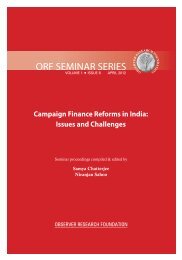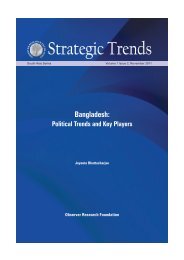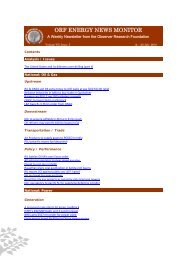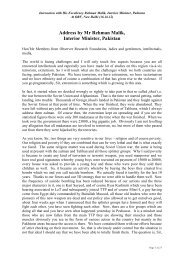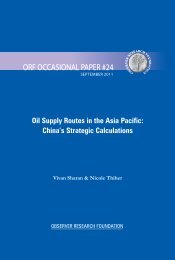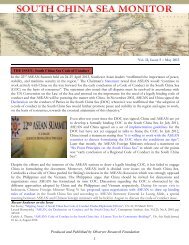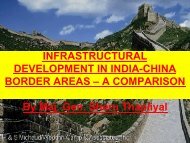Affirmative Action in Private Sector in Malaysia - Observer Research ...
Affirmative Action in Private Sector in Malaysia - Observer Research ...
Affirmative Action in Private Sector in Malaysia - Observer Research ...
You also want an ePaper? Increase the reach of your titles
YUMPU automatically turns print PDFs into web optimized ePapers that Google loves.
mult<strong>in</strong>ationals <strong>in</strong>clud<strong>in</strong>g speedier clearance of projects, provid<strong>in</strong>g quality <strong>in</strong>frastructure, tax<br />
concessions 20 , re<strong>in</strong><strong>in</strong>g over labour union and wage rate among others.<br />
Yet, there were many areas of concerns for the foreign companies, particularly the ICA and<br />
Petroleum Development Act (PDA) of 1974 21 and its subsequent amendments 22 . In fact, the<br />
PDA proved such an <strong>in</strong>trusive law that Esso <strong>Malaysia</strong>, an oil company decided to pull out f<br />
its oil exploration efforts pend<strong>in</strong>g a more favorable policy. Several other companies<br />
threatened to follow Esso’s path. After a long negotiations, the government decided to drop<br />
the idea of management share was dropped and its strongest advocate Tengku Razaleigh<br />
Hamzah was transferred from his job as Chairman of Petronas <strong>in</strong> 1976. Similarly, on ICA the<br />
government conceded too many demands of the mult<strong>in</strong>ationals. In other words, when it came<br />
to foreign companies, most of the leaders were sufficiently flexible and ready to walk miles<br />
to accommodate their concerns. This was <strong>in</strong> complete contrast to their response to Ch<strong>in</strong>ese<br />
demands to repeal ICA and related <strong>in</strong>struments that adversely impacted their bus<strong>in</strong>ess. Such<br />
<strong>in</strong>centives and policy flexibility shown by Malay leadership conv<strong>in</strong>ced the MICCI, the<br />
foreign bus<strong>in</strong>ess chamber to accept the NEP as a fait accompli and merely press for the<br />
removal of the excesses and <strong>in</strong>consistencies <strong>in</strong> the ICA. The chamber was not will<strong>in</strong>g to<br />
unnecessarily alienate the government by ask<strong>in</strong>g to repeal it (Jesudason, 1990). In short, there<br />
was clear trade-off between the state and foreign companies <strong>in</strong> the context of the NEP.<br />
To sum up the trends and dynamics of private sector participation <strong>in</strong> affirmative action as laid<br />
out by the NEP, one saw a sort of mixed trends of responses and trade-offs. In terms of<br />
responses, they ranged from outright antagonism to reluctant participation although it<br />
differed from one group to the other. While Ch<strong>in</strong>ese vehemently opposed NEP restrictions <strong>in</strong><br />
the beg<strong>in</strong>n<strong>in</strong>g, yet as time progressed and pressures to fall <strong>in</strong> the l<strong>in</strong>e persisted, majority of<br />
big and medium firms agreed to restructure ownership and employment. Many others among<br />
them fulfilled NEP targets by other means ma<strong>in</strong>ly through “Ali-Baba” route, manipulat<strong>in</strong>g<br />
and circumvent<strong>in</strong>g rules through procedural loopholes and so on. In the case of foreign<br />
companies, they probably got better deal from the state compared to Ch<strong>in</strong>ese and therefore,<br />
they never openly opposed the NEP goals and tried to accommodate Malay <strong>in</strong>terests with<strong>in</strong><br />
their permissible limits. Overall, most of the new jobs were created by mult<strong>in</strong>ationals as they<br />
had a massive presence <strong>in</strong> the manufactur<strong>in</strong>g sector, thereby contribut<strong>in</strong>g maximum to NEP<br />
objectives.<br />
<strong>Affirmative</strong> <strong>Action</strong> and the <strong>Private</strong> <strong>Sector</strong>: An Assessment<br />
As seen from the above discussion, the chief motivation beh<strong>in</strong>d the NEP was to restructure<br />
the corporate ownership and correct the perceived Malay under-representation <strong>in</strong> the modern<br />
sectors of the economy. In realization such ambitious goals, the government chose private<br />
sector as one of the key vehicles. The government pressed private sector to restructure 30 per<br />
cent of their ownership shares to benefit the Malays, accommodate Bumiputeras <strong>in</strong>to top<br />
management positions and provide employment apart from tra<strong>in</strong><strong>in</strong>g, exposure, and other<br />
support measures to help Bumiputeras. The next logical question, therefore, is how did it<br />
work and with what consequences? Are there any takeaways from such experiment for<br />
countries such as India?<br />
Let us first consider the issue of restructur<strong>in</strong>g of equity capital <strong>in</strong> corporate sector which <strong>in</strong><br />
actual sense was regarded as the most important reason beh<strong>in</strong>d the formulation of NEP



